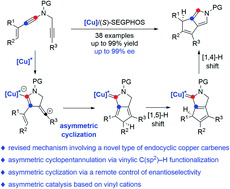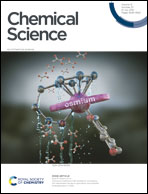Copper-catalyzed asymmetric cyclization of alkenyl diynes: method development and new mechanistic insights†
Abstract
Metal carbenes have proven to be one of the most important and useful intermediates in organic synthesis, but catalytic asymmetric reactions involving metal carbenes are still scarce and remain a challenge. Particularly, the mechanistic pathway and chiral induction model in these asymmetric transformations are far from clear. Described herein is a copper-catalyzed asymmetric cyclization of alkenyl diynes involving a vinylic C(sp2)–H functionalization, which constitutes the first asymmetric vinylic C(sp2)–H functionalization through cyclopentannulation. Significantly, based on extensive mechanistic studies including control experiments and theoretical calculations, a revised mechanism involving a novel type of endocyclic copper carbene via remote-stereocontrol is proposed, thus providing new mechanistic insight into the copper-catalyzed asymmetric diyne cyclization and representing a new chiral control pattern in asymmetric catalysis based on remote-stereocontrol and vinyl cations. This method enables the practical and atom-economical construction of an array of valuable chiral polycyclic-pyrroles in high yields and enantioselectivities.



 Please wait while we load your content...
Please wait while we load your content...